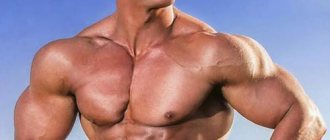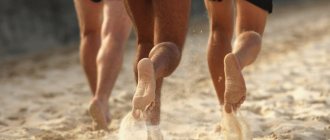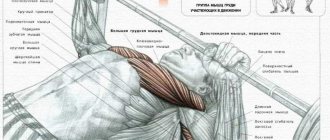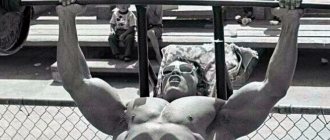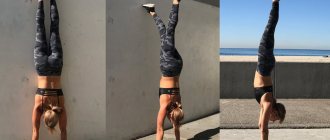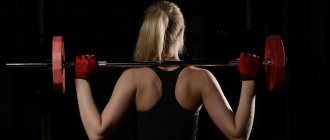Home ▸ Articles ▸ Workouts ▸ How to build muscles: a complete guide from a cool trainer
How to build muscle as quickly as possible is what this comprehensive guide is all about. Become big, strong, slender and built like Apollo.
The techniques you'll learn about will help you overcome terrible genetics and gain good muscle mass if you work hard and smartly. But first the bad news...
If you're a genetically average guy or a "skinny fatty" who's really struggling to gain strength, build muscle, and lose fat, you've probably been lied to. You have been fed a lot of crap about how to transform your body, which will never work for someone like you. For example:
● you should not do anything other than massive strength gains and Olympic-level exercises;
● you should always work extra hard no matter what;
● isolating (isolated) exercises are useless;
● you should always do a full body workout;
● circuit training is the fastest way to get rid of problems;
● crunches and cardio give you six-pack abs;
● you should eat 6-7 times a day;
● You should eat 2 grams of protein per pound of your body weight;
● carbohydrates are the devil;
● You should buy this supplement or take this drug to build muscle mass.
All this is complete nonsense. The only thing you'll get by following these tips is an extensive list of annoying injuries and zero in your checking account. Try Jason Ferrugia's training and nutrition method specifically for skinny, injury-prone guys.
He is a world-renowned strength and endurance specialist and muscle-building expert. And also one of the most sought-after fitness trainers in the United States and “the most controversial personality in the fitness industry” thanks to his bold fitness ideas.
Ferrugia's Renegade Method is ideal for all guys over 35 who need to improve their training as they age. It has been tested on thousands of students and has given amazing results. This method is especially suitable if:
● you have little time;
● you are not taking steroids or performance enhancing drugs;
● you don’t have good genetics to build muscle and strength;
● you're tired of getting injured from training and feeling like crap all the time.
Nobody promises plus 34 kg of muscle in the next month or anything like that. You still need to be patient and take the time. But you'll see some results within a few weeks of this plan, and big results within a few more months.
If you follow the program and work hard, you will get results. Never give up after a few days. Don't look for excuses or an easier way. Don't be sheep. Be lions.
Rule #1: To build muscle, you need to get stronger.
You can't expect to change your physique by doing the same workouts over and over again. You have to force adaptation to happen. The easiest way to do this is to increase the weight of the barbell. Get stronger primarily in the 5-10 rep range and you will get bigger.
Hard training always gives better results than light training. It's just common sense. The more weight you use, the more muscle fibers you can recruit.
How do you know you're getting stronger? Regularly setting personal records. Choose a few key exercises that work your entire body together. Presses, pull-ups, rows, squats and deadlifts are the best choices (more on this in Rules #2 and #3).
Write down how much weight you can currently lift for 5-10 reps of each, and over the next few months work your way up to the point where you can add 4-9kg to each of these exercises or do 3-5 repetitions with the same weight. This is how you make your body grow.
When you reach the upper limit of the rep range, add weight and start again with 5 reps. Simple but extremely effective; no advanced math degree required.
The point is this: to become big, you need to become strong.
Rule #2: You Must Use Compound Exercises to Build Muscle
Exercises that allow you to use the heaviest weight will build muscle the fastest. These are also the climbs that allow the greatest percentage increase in load. Here we are talking about complex (multi-joint) exercises with free weights. You won't be able to grow at nearly the same rate if you train on machines and do isolation movements.
You have to overload your body with big, serious, testosterone-producing lifts. The best compound strength exercises to build muscle:
● military presses (overhead) - lifting the barbell while standing from the chest above the head. Also performed with dumbbells or kettlebells;
● Incline bench press – barbell or dumbbell. I like to set the tilt angle to no higher than 45 degrees. Around 30 is excellent. This helps protect the shoulders, which are at high risk of injury during a typical bench press;
● squats - with a barbell on the back, with a barbell on the chest, with a safety bar, a buffalo bar, with a rubber loop;
● deadlift – regular, sumo, with trap bar, Romanian, from platform/racks;
● rowing movements – with dumbbells in one hand, with chest support, landline;
● carried with weights (probably so) - this could be a farmer’s gait or carrying a sandbag or stone in different positions: bear hug, carried on the crook of the elbows, under the chin or on the shoulders;
● working with weighted sleds - pushing or pulling a sled or Prowler.
Get stronger at these exercises by slowly adding weight and reps.
When you can perform an impressive amount of these variations in sets of 5-10 reps, you'll be a big guy.
How to develop your legs
It is often mistakenly believed that jumping and jumping “swing” the legs. Repeated jumping rope, running and other cardio activities are more likely to develop endurance. To develop strength, you will either have to jump on a support, for example, a box 50 cm high, or perform movements with weights.
You can realistically do the following movements at home:
- Goblet squats and pause squats;
- Lunges with dumbbells;
- Squats with dumbbells on the chest and a rubber shock absorber;
- Dumbbell floor rows and Romanian rows
- If more significant weight is required, it is recommended to either add rubber shock absorbers, or switch to “one-legged” versions of squats and deadlifts, or, nevertheless, go to the gym.
Rule #3: Complement big lifts with bodyweight exercises
Barbell and dumbbell lifts are the foundation, but you'll need more than that to train injury-free and long-term. These exercises should be supplemented with an equal amount of muscle building and body weight building exercises. For example:
● pull-ups;
● push-ups on rings or between boxes while hanging;
● variations of squats and lunges on one leg;
● push-up options;
● Inverted rows - ring rows, but with feet on a bench or box;
● plank options;
● Glute-ham Raises - rises on a Roman chair.
Bodyweight training develops strength and stability throughout the body. They are also gentle on your joints, allowing you to build muscle without straining your connective tissue.
A combination of big lifts and bodyweight exercises will result in an athletic, balanced, muscular physique that will last for years to come.
My free materials
There are free products on my blog that you can download and explore.
The most popular of them is the “System for choosing an individual training program,” which I already introduced you to.
The system is very popular among blog readers and new visitors, because... explains in a simple and understandable, step-by-step manner all the intricacies of the first training program.
There are two more great books:
- "Your friend is a bodybuilder."
- "The other side of a beautiful body."
These books help you start training and learn all the most basic aspects of training.
The book “The Other Side of a Beautiful Body” talks about what changes in a person’s life when he or she starts bodybuilding.
I advise you to study my free materials. Even though they are free, this does not affect their quality in any way.
I am very meticulous in the release of my articles, materials and products, so I am constantly working to improve them and provide feedback to readers.
Rule #4: To build muscle safely, you need to use perfect technique.
Yes, this should go without saying, but walk into any public gym and you'll find that this rarely happens. People will work in any form that allows them to lift weights, but that doesn't mean they did a good rep. The ideal set consists of several components. Here's what you need to do:
● Tense yourself from head to toe before lifting the weight. Squeeze the fingerboard (or other instrument) as if you were trying to crush it. If you do the exercise standing, be sure to tighten your buttocks and abs. Tension throughout the body creates stability, making the lift stronger and safer.
● Control the lowering or eccentric portion of the lift. This helps you control your weight better for safety and hits your muscles harder to promote growth.
● Allow the muscle to stretch in the lower position, but do not go so far that you feel pain. You should also not experience stress on your joints.
● Begin the positive (concentric) portion of the lift by contracting the target muscles forcefully. So, if you're doing a dumbbell press from the bottom up, squeeze your pecs first.
● Do not use excessive inertia. Lift your muscles rather than reflexively stretch. No bouncing reps.
● For barbell exercises, you should lock out at the top and reset for the next rep. Don't try to quickly gain reps.
● For bodyweight and dumbbell exercises, you should stop, simply avoiding lockout at the top, and immediately change direction. Think of constant tension and continuous movement.
Rule #5: Train at the optimal volume to build muscle.
For young guys who really want to increase their strength, 5-8 reps are ideal. If you are over 35 or have been training properly for a couple of years, you can increase the reps a little and start doing more sets of 10-12 reps in addition to the 5-8.
As you become more advanced or over 40, you'll want to spend a little more time in the 8-12 rep range and less time in the 5-8 rep range, just to protect your joints from heavy loads and reduce the risk of injury.
Most guys with an average level of training prefer to combine low and high repetitions in one exercise. So, after you've done some serious lifting work, do a few sets of a little more reps and get pumped up.
As you do more reps, focus on the muscle you're trying to build and get the most out of it. Yes, as silly as it may sound, visualizing muscles working and growing during a workout can be helpful.
A 2016 study from the European Journal of Applied Physiology found that when athletes think about their pecs and triceps during exercise, they activate them better.
If you've been training properly for at least three years, you'll find that advanced pumping techniques like rest-pause sets, drop sets, and some of the other old bodybuilding techniques you've no doubt heard of can be beneficial when used in moderation . Just don't overdo it with them. And never stray from the most important rule: make your personal best stronger.
While the number of reps you do per set is important, the total number of reps you do for each muscle group is equally important. The National Strength and Endurance Association has determined that for maximum growth you need approximately 20-70 repetitions per muscle group.
Depending on which end of the rep range you're working on, this can be done in one workout or over multiple days (like a training week), but you need to cover that spread to see gains. This means that if you're doing 6 reps per set, you need to do at least 3 full sets—and more than 12—for that particular muscle group.
Jason Ferrugia recommends starting at the bottom of the scale. Turn up the volume only when absolutely necessary. So, if you're training your chest, you can start by doing 6 working sets of dumbbell presses, split into two sets per workout of three sessions per week. You can then gradually add sets, experimenting with different training splits that will allow you to get more volume without overtraining.
As you progress, you can alternate between phases of lower and higher volume with the help of a properly designed training program.
Newbie mistakes
To begin with, those who want to know how to pump up at home google biceps exercises and begin to do them fanatically. But the point is not at all in the biceps, but in the absence in the body of the prerequisites for creating an anabolic background. Simply put, a person simply “has nothing to grow” muscles from, especially if he neglected nutrition and believed that if he was training at home, then mashed potatoes with sausage would pass for an athlete’s diet.
The most important mistake is the reluctance to develop strength. Yes, yes, all the athletes of the “golden era” were good strength athletes. And even any modern crossfitter will perform CCM on individual movements in powerlifting. But the gloss of sports convinces us that “it will do” - bend your arms with something, do some exercises in a high-repetition mode, and you will get pumped up. No. Strength, by the way, can be developed to a certain limit at home. The only question is desire.
High expectations
Yes, guys are even worse than girls in this regard. If the latter believe that after a couple of series of glute bridges without weight and some steps to the side with elastic bands, they will look like protruding fitness bikinis, then the former are ready to argue with foam at the mouth that the same Denis Gusev could to pump up on horizontal bars if he didn’t have access to the gym. Everyone needs a role model, but if you do home fitness, you don't need to set goals like “look like a model in 3 months.”
The myth of champion volumes
Almost any person who has a photo on Instagram with huge shoulders and biceps can fit into a standard suit in life. Yes, big guys pump up their muscles before recording the results of their labors. And poor beginners do 200 repetitions with biceps expanders just to get any closer. Of course, you can develop endurance in this way, but not strength or volume.
Lack of motivation
We are not talking about videos from the Internet, where guys from the ghetto do pull-ups on the horizontal bars, and their wealthier “sports colleagues” pump iron in expensive gyms. We are talking about banal laziness. Biceps and deltoids may not be a priority for a student - for example, he is ready to play a game until 2 a.m. and then sleep through the workout. Or go have a beer instead of working out on the horizontal bars. Or... And if summer comes, you should completely forget about your studies. It's hot! In winter it is cold. In autumn - depression. And so on, in a circle. The one who will fanatically carry out the exercise program for years will get pumped up.
How to Build ALL Muscles at Home WITHOUT Iron!
Rule #6: Distribute your training days correctly
First, you don't have to train six days a week like a bodybuilder. Three to four days of heavy strength training per week is ideal for most busy, average genetic people who are not using steroids.
The best training plan is one that allows you to:
● recover correctly;
● increase your strength as much as possible;
● save joints and spine.
The frequency with which you train each muscle group usually decreases the more years you train.
Beginners:
If you are a beginner, you need 3 full body workouts per week. In each, perform a compound pushing movement (eg bench press), a compound pulling movement (eg chin-up), and a compound lower body exercise (eg squat, barbell deadlift). If you want to add 1-2 other exercises to finish, such as weight carries or kettlebell swings, that's fine, but three exercises is enough to work the entire body.
A 2015 study published in the Journal of Strength and Conditioning Research found that subjects who trained their entire body three times a week gained more arm size than another group that split their body parts, working each muscle only once.
Continued:
If you've been training for longer than 6-12 months, you can split your workouts into upper and lower body days. The most common setup is to train the upper body one day and skip the next, so each area is trained twice a week.
If you train four days a week, you could train your upper body on Monday, your lower body on Tuesday, rest on Wednesday, and then do your upper body again on Thursday, your lower body on Friday, and then rest on the weekend.
You should still rely mostly on compound lifts, but adding in some isolation work like shoulder lateral raises and dumbbell bicep curls is okay.
If you train three days a week, you can alternate upper and lower body days each time you train. You can use this method for two weeks:
1 Week
- Monday: upper body.
- Wednesday: lower body.
- Friday: upper body
2 week
- Monday: lower body
- Wednesday: upper body
- Friday: lower body
If you train three days a week and prefer to set your training days each week rather than alternating them, have a hard upper body day on Monday, legs on Wednesday, and then an easier upper body day on Friday when you increase a little number of repetitions and perform less strenuous exercises.
So instead of doing incline barbell presses for sets of 5-6 reps, you can do dumbbell incline presses or weighted ring push-ups for sets of 8-12 reps.
Advanced:
Top/bottom division can always be used. Many big, strong powerlifters stick to this throughout their entire career. However, if you are older and/or have recovery issues, you may prefer a push/pull/legs split where you train all at once once a week. This is how most famous bodybuilders trained in the past, and many continue to do so.
You can do chest, shoulder, and triceps exercises on Monday, back and biceps exercises on Wednesday, and leg exercises on Friday. If you want to train your arms or "beach muscles" (abs, chest, upper back and shoulders) on Saturdays, you can expand these workouts to a four-day-a-week program.
Most typical bodybuilding programs use too many sets and repetitions and use the wrong exercises. However, if you reduce overall volume, go heavier, and use compound movements, there is nothing wrong with splitting body parts for advanced lifters. In fact, it is often less stressful on the joints than a conventional top/bottom pattern.
In terms of frequency, training a muscle group once every 5-7 days is actually safer and more effective for advanced lifters than training it two or three times a week. If you want to increase your frequency a little, there are ways to do it without adding extra training.
You can add one or two lighter sets of work for the muscle group you want to train on days other than your main workout for that muscle. For example, if you want to train your arms, you can do one or two sets of dumbbell curls to begin your leg workout.
How to pump up muscles for a girl. Differences from men's training
Despite the fact that we are one biological species, our approach to the training process should be somewhat different for the following reasons:
- Girls have much less testosterone (the main anabolic hormone) by about 10 times.
- The depth of immersion in a state of muscle failure is different for men and girls.
- The nutrient accumulation system in girls works more intensively.
- Women's muscle size is smaller than men's.
- Women have less muscle in their upper body than in their lower body.
- The difference is in the one rep max.
- Monthly cycle.
I will not consider the above reasons in detail now. Below I will provide links to articles that girls will definitely need to read, where all the intricacies of women's training are described in detail.
The main thing to understand is that girls and boys cannot train according to the same training schemes.
Very often I see how guys, and even worse, coaches, train their girls or wards using the same type of programs.
The girls have been plowing for months, but there is practically no progress. All such training in men's programs for an unprepared girl, as a rule, is accompanied by severe overtraining and very weak progress.
6 Conclusion: The training process for girls and men should be different due to structural features and differences.
Required (!) reading:
- The best training program for girls;
- How to gain muscle mass for a girl;
Rule #7: “Stimulate, don’t destroy”
This is a quote from eight-time Mr. Olympia Lee Haney. This means you need to train hard, but smartly.
Don't kill yourself in the quest to become big and strong. When you leave some gas in the tank, both at the end of each set and after each workout, you increase your chances of success.
Don't push sets to failure where you absolutely can't do another rep. You should never get to the point where you turn purple and scream. In most cases, you'll want to finish the sets two reps before failure. Not sure when this will be? The moment your form breaks or you are almost certain it will break, end the set.
I like a great analogy: balancing training and recovery is like digging a hole. Every time you rise, you dig deeper and find it difficult to get out of the hole. To get out again, you must fill the hole to get back to ground level, and the only way to fill it is by eating and resting. If you overdo it in the gym, pushing too hard, you won't be able to train as often or as hard. Eventually you will get injured.
Rule #8: Stay fit
Cardio does NOT make you small and weak, even if you are a skinny athlete to begin with.
Skipping endurance work will make you lazy, out of shape, with a fat butt. Endurance exercise will help you stay lean and athletic, and improve your recovery between strength training sessions. This is very beneficial and should be part of your weekly routine.
Jason Ferrugia's favorite form of cardio is high-intensity interval training (HIIT). It has been proven to be extremely effective at burning fat and increasing fitness levels while preserving muscle mass.
You should still do at least one 15-30 minute HIIT workout per week, even if you're trying to build muscle as quickly as possible. If you are trying to lose weight, you should do 2-3 HIIT workouts per week.
To do HIIT correctly, pick an exercise (or series of exercises) and try to perform it as quickly and as hard as possible for 30 to 60 seconds. In fact, for the sake of safety, it is preferable to give 90-95% of your maximum effort. Then you coast (or rest, depending on the exercise) for 60–120 seconds. Repeat the sequence for 15-30 minutes.
Jason Ferrugia's Favorite HIIT Exercises
● Uphill sprint
● Sprint while pushing or pulling a weighted sled
● Sprint on a high-resistance bike
● Kettlebell swings or snatches performed with high repetitions
● Jumping rope
● Swimming
● Rowing (if your back can handle it)
In addition to your HIIT sessions, it's always a good idea to take a 30-60 minute walk as many days a week as possible. It is recommended to take at least 10,000 steps every day. Use a phone app to track them.
If you jog, swim, hike, or do any other form of long-lasting, low-intensity cardio exercise, you can do that as often as you like.
Proper nutrition during training
Let's consider the principles of nutrition for those who plan to build muscle mass and get the maximum effect when pumping the body at home.
1. Eat more protein. It’s easy to calculate the amount - per 1 kg of weight there should be 1.5 grams of protein. For example, your weight is 80 kg, which means your protein requirement per day is 120 grams.
Which foods contain enough protein:
- red meat - beef, pork, lamb;
- fish - tuna, salmon, swordfish, perch, trout, mackerel;
- poultry - chicken, turkey, duck breasts;
- eggs, especially egg whites;
- dairy products - milk, cheese, cottage cheese, yoghurts.
2. Consume complete proteins.
What is the difference? It's simple - if the protein is of animal origin, it is considered complete. If you're a vegetarian, don't worry either. Complete proteins can be obtained from beans, lentils, buckwheat, and rice.
3. From carbohydrates, choose complex ones, not fast ones.
Fast carbohydrates are baked goods, fast food, and foods high in sugar. Complex - various cereals (oatmeal, brown rice), durum wheat pasta, rye bread, etc.
4. Eat healthy fats.
Do you remember about the BJU balance? Fats are there too and they are important, even if your goal is to pump up at home and get ripped abs. In general, you should get 20-30% of your daily calories from fat. The right fats are fish, nuts, cold-pressed oils, flax seeds, pumpkin seeds, etc.
Rule #9: Make recovery a priority
Training is simply a stimulus for growth. You grow outside the gym when you recover; not during training. If you can't recover, you won't grow. Simply and easily.
So how can you ensure proper recovery after training? Adhering to the following:
● don't do more than you can do in the gym;
● do not train for more than an hour at a time;
● do not use extreme levels of psyche in each approach;
● keep stress under control;
● sleep 8–9 hours every day;
● meditate;
● perform at least 15–20 minutes of mobility exercises and self-myofascial release (for example, foam rolling);
● doing some low-intensity exercise and/or yoga (or other stretching exercises) on weekends;
● take contrast baths and showers;
● Get a massage once a month or as often as you can afford.
Ideal products
All these natural products will help you gain weight:
- Pasta, potatoes and sweet potatoes for carbohydrates;
- Legumes of all types - for carbohydrates and protein;
- Rice is the most accessible source of energy for a bodybuilder;
- Eggs, poultry – protein;
- Fish and seafood – protein and omega-three;
- Beef and offal – protein and iron;
- Vegetables - fiber;
- Fruits – energy of vitamins and natural simple carbohydrates;
- Nuts – for healthy fats
Bonus Rule: Consistency is Key
All the information above will be completely useless if you do not apply it consistently. It's not about the week. We are not talking about two months.
The greatest progress is made by those who consistently perform 3-4 workouts per week. The guy who never skips a meal, always goes to bed on time, spends several hours a week on home restoration techniques, and repeats this process 52 weeks a year, year after year. This is how real progress is made.
You have to commit and believe in what you are doing. You can't change your routine after a week. You can't constantly be on the Internet looking for the best program.
There are no magic supplements or yet-to-be-discovered secret training techniques that will help you build 100 pounds of muscle in the next three months. These things will never happen.
The only thing that produces results is passion, commitment and hard work. Every damn day.
Lift weights. There are steaks. Run up the hills. Sleep. Repeat.
My results
The easiest way to test a person's knowledge is HIS OWN RESULT!
I have been involved in bodybuilding on a regular basis for over 8 years now, and have done a lot of experiments, both in training and in nutrition.
Tried hundreds of different supplements, which allowed me to draw my own conclusions about their effectiveness.
I cut and gained muscle mass many times.
Here are my results:
I truly love what I do.
For more than 4 years I have been running this blog, into which I invest a lot of effort, time and money to create a resource that will help thousands of people become much more beautiful and self-confident.
I won't write much about myself here.
If you want to get to know me, you can read the Author page. There I talked about my studies at two Universities, the Academy of Bodybuilding and Fitness Professionals, the army, snowboarding (my second passion), my family and my life.

